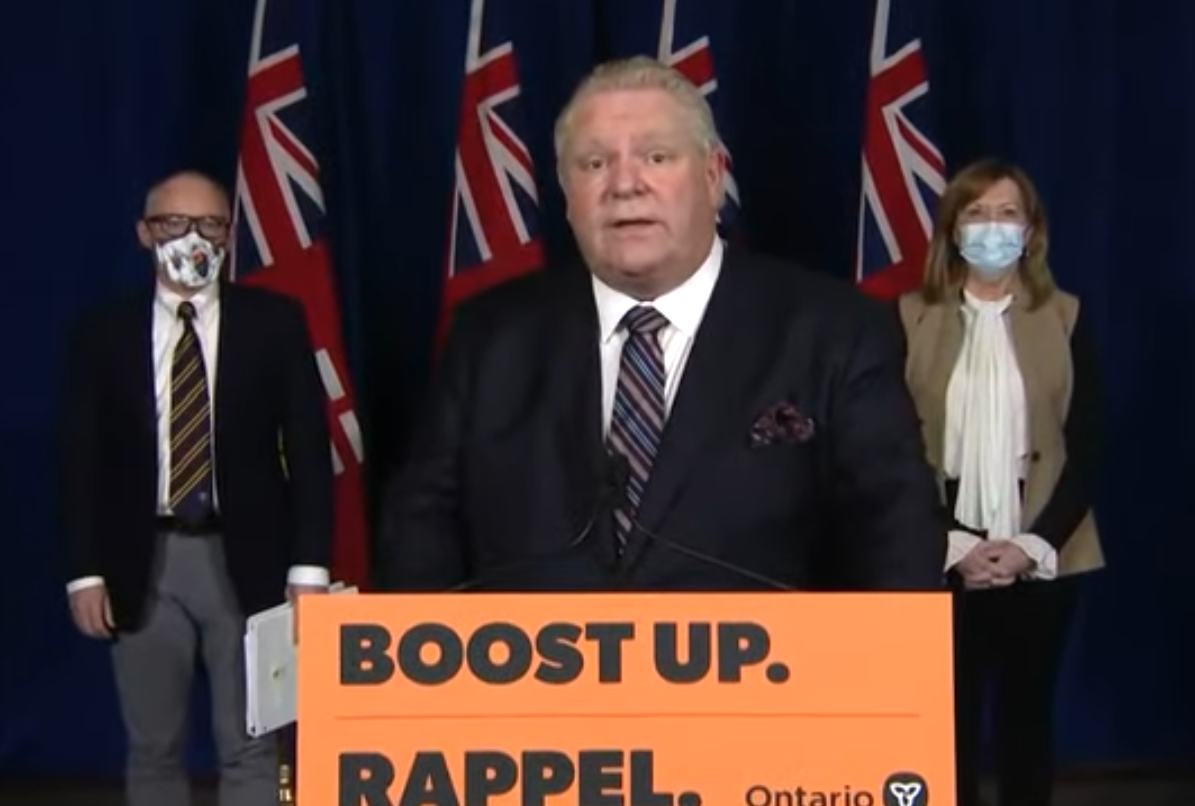TORONTO – Premier Doug Ford was prompt in announcing Thursday morning that COVID-19 public health measures will “cautiously and gradually” ease later this month.
A few minutes after his scheduled 11:30 a.m. media conference, Ford stood at the podium and told reporters that evidence is showing the public health measures introduced on Jan. 5 are working.
“The evidence tells us that the measures we put in place to blunt transmission of Omicron are working,” said Ford.
“We can be confident that the worst is behind us and that we are now in a position to cautiously and gradually ease public health measures.”
Ford said the province’s data is showing test positivity rates have fallen from near 40 per cent at the beginning of the month to around 15% today.
In addition, new admissions to hospitals have begun to stabilize, and the length of stay has shortened considerably.
Based on the current data, the province will begin the first of three announced phases to lift public health measures on Jan. 31, with 21 days between each phase.
“Thanks to the sacrifices of Ontarians we are starting to see glimmers of hope,” said health minister Christine Elliott.
“As we continue to chart our path forward, we will continue to take a gradual and cautious approach to lifting public health measures to protect our hospital capacity and ensure patients can continue to access the care they need.”
Beginning Jan. 31, some of the changes to public health measures include increasing social gathering limits to 10 people indoors and 25 people outdoors (current five and 10, respectively), and increasing or maintaining capacity limits at 50 per cent in indoor public settings such as:
- restaurants and bars without dance facilities;
- retailers, including grocery stores and pharmacies;
- shopping malls;
- cinemas;
- meeting and event spaces;
- museums;
- casinos, bingo halls and other gaming establishments;
- religious services, rites or ceremonies; and
- spectator areas of facilities such as sporting events, concert venues and theatres (the lesser of 50 per cent capacity or 500 people).
Enhanced proof of vaccination and other requirements would continue to apply in existing settings.
If positive trends for key public health and health care indicators, such as hospital capacity and test positivity rate, continue, the next phase of reopening would begin Feb. 21.
Some of the measures to be lifted on Feb. 21 include:
- increasing social gathering limits to 25 people indoors and 100 people outdoors;
- removing capacity limits in indoor public settings where proof of vacation is required, such as restaurants, recreational facilities and cinemas;
- limiting capacity in most remaining indoor public settings where proof of vaccination is not required to the number of people who can maintain two metres of physical distance;
- indoor religious services, rites or ceremonies limited to the number that can maintain two metres of physical distance, with no limit if proof of vaccination is required; and
- increasing indoor capacity limits to 25 per cent in the remaining higher-risk settings where proof of vaccination is required, including nightclubs, wedding receptions in meeting or event spaces where there is dancing, as well as bathhouses and sex clubs.
Enhanced proof of vaccination, and other requirements would continue to apply in existing settings.
Again, if public health trends allow, further restrictions would be lifted on March 14, including:
- lifting capacity limits in all indoor public settings (proof of vaccination will remain in existing settings in addition to regular measures);
- lifting remaining capacity limits on religious services and ceremonies; and
- increase social gathering limits to 50 people indoors, with no limits for outdoor gatherings.
More information on public health measures in Ontario can be viewed at https://covid-19.ontario.ca/public-health-measures.
Too ambitious?
Ford and Dr. Kieran Moore, Ontario’s chief medical officer of health, were asked if the province’s announcement in October about lifting all public health measures by April was premature.
Moore responded by saying that given the data available to officials in October, they felt confident in making such a statement.
“We had a good plan in place for Delta,” said Moore.
However, with Omicron being identified as a variant of concern at the end of November, the plan had to be adapted.
“We’ve responded to a new variant quite appropriately,” said Moore.
“Sadly, we’ve had to put public health measures in play at present to best protect Ontarians and the health care system.
“Thanks to Ontarians and all of the sacrifices they’ve made, it has made a difference. Our health system has been able to provide the right care at the right time for any patient with COVID-19.”
Added Moore, “We have to be adaptive for any new variant, and Ontarians have done that for Omicron.
“We do see light at the end of this phase of the pandemic… we do see hope that the sacrifices have been worth it.”



